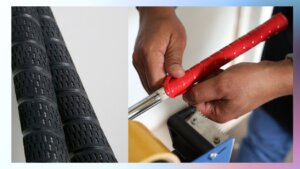
Golf, a sport that combines skill and precision, relies heavily on the equipment used, and one often overlooked aspect is the condition of the grips on golf clubs. The question that lingers in the minds of many golf enthusiasts is, “How much does it cost to regrip golf clubs?” In this comprehensive guide, we’ll delve into the intricacies of regripping, exploring everything from signs indicating the need for new grips to economic considerations and future trends in grip technology.
The importance of well-maintained grips on golf clubs cannot be overstated. Worn-out grips can adversely impact your game, leading to a loss of traction and affecting your ability to control your swings effectively. In this guide, we will not only answer the burning question about the cost of regripping but also provide valuable insights into the entire process.
Read also: How to Become a golf club fitter
How much is it to get a set of clubs Regripped?
The cost of regripping a set of golf clubs can vary depending on several factors but generally falls within the range of $100 to $220 for a full set of 14 clubs. Here’s a breakdown of the key factors influencing the price:
1. Grip Cost:
- Budget Grips: Starting around $5 per grip, these are typically made from synthetic rubber and offer basic performance.

Budget golf club grips - Mid-Range Grips: Ranging from $7 to $12 per grip, these often feature improved tack and feel compared to budget options.

Midrange golf club grips - Premium Grips: Costing $15 or more per grip, these grips boast advanced materials and technologies for enhanced performance and comfort.

Premium golf club grips
2. Labor Cost:
- DIY Regripping: This is the most budget-friendly option, requiring only the purchase of grips and basic tools. However, it demands some technical skill and can be time-consuming.
- Professional Regripping: Golf shops typically charge $3 to $10 per club for labor, offering convenience and expertise but at a higher cost.
3. Additional Services:
- Double-sided tape replacement: Around $1 to $2 per club, this ensures a secure grip attachment.
- Shaft adjustments: Services like lie/loft adjustments or re-shafting add to the overall cost, typically ranging from $15 to $50 per club.
Here’s a rough estimate of regripping costs based on grip choices and service type:
- DIY with budget grips: $70 to $100
- Professional regripping with mid-range grips: $150 to $200
- Professional regripping with premium grips and tape replacement: $200 to $250
Remember, these are just estimates, and the actual cost may vary depending on your specific needs and the shop’s pricing. It’s always best to call your local golf shop for a precise quote.
I hope this information helps you budget for regripping your golf clubs!
Read also: How to Make a Golf Cart Faster 2024
How Much are Golf Clubs?
The price of golf clubs can vary widely depending on a number of factors, including the brand, the quality, the type of clubs (e.g., irons, driver, putter), and whether they are new or used.
- For a beginner set of new clubs, you can expect to spend anywhere from $200 to $1,000.

Beginner golf clubs - For a more advanced set of new clubs, you can expect to spend anywhere from $1,000 to $3,000.

Advanced golf clubs - For a top-of-the-line set of new clubs, you can expect to spend $3,000 or more.

Top-of-the-line golf clubs You can also save money by buying used clubs. Used clubs can be a great option for beginners or for golfers who are on a budget. You can find used clubs online, at golf shops, or at pawn shops.
Here are a few things to keep in mind when buying golf clubs:
- It is important to get fitted for clubs. This will ensure that the clubs are the right size and weight for you.
- Don’t be afraid to haggle. Golf clubs can be expensive, so it is always worth trying to get a good deal.
- Take your time and do your research. There are a lot of different golf clubs on the market, so it is important to find the ones that are right for you.
I hope this helps!
Signs of Worn-out Grips
Before we dive into the costs, it’s crucial to recognize when your golf club grips need replacing. Loss of traction, visible wear and tear, and a noticeable impact on swing control are telltale signs that it’s time for a change.
Frequency of Regripping
Golfers, both seasoned and novices, often find themselves pondering the optimal frequency for regripping their beloved golf clubs. The grips on your golf clubs play a crucial role in ensuring control, precision, and overall performance.
Understanding when to regrip is essential for maintaining peak functionality. Let’s delve deeper into this aspect to help you make informed decisions about the frequency of re-gripping.
General Guidelines
To establish a solid foundation, it’s beneficial to follow some general guidelines regarding how often you should regrip your golf clubs. Industry experts and golf equipment manufacturers typically recommend regripping every 40 rounds of play.
This guideline is a reasonable starting point and ensures that your grips remain in optimal condition, providing the necessary traction and feel during your swings.
Factors Influencing Regripping Frequency
While the 40-round rule offers a baseline, it’s essential to consider various factors that can influence the frequency of regripping based on your individual circumstances.
1. Playing Frequency:
- The more frequently you play, the quicker your grips will wear out. Regular players may need to regrip more often than occasional golfers.
2. Playing Conditions:
- Environmental factors, such as extreme temperatures and high humidity, can accelerate grip wear. Players in humid climates may notice a faster deterioration of their grips.
3. Grip Material:
- Different grip materials have varying lifespans. Rubber grips, for instance, may wear out faster than corded grips. Understanding the characteristics of your chosen grip material is crucial.
4. Storage Practices:
- How you store your clubs also influences grip longevity. Leaving clubs exposed to the elements, especially sunlight and moisture, can expedite the wear and tear process.
5. Swing Intensity:
- The intensity of your swings and the force exerted during gameplay can impact grip wear. Players with a more aggressive swing style may find themselves needing to regrip more frequently.
6. Personal Preferences:
- Some golfers may be more sensitive to changes in grip feel than others. If you notice a decline in performance or comfort, it might be time to consider regripping, even if you haven’t reached the 40-round mark.
Monitoring Your Grips
Keeping a close eye on the condition of your grips is the key to determining when regripping is necessary. Look for visible signs of wear, such as smooth or shiny areas on the grips, cracks, or loss of tackiness. Regularly inspecting your grips allows you to address any issues promptly, ensuring that your golf equipment is always in top-notch condition.
Customized Approach
Ultimately, the frequency of regripping is a personalized matter. While general guidelines provide a starting point, paying attention to the unique factors influencing your equipment’s wear and your personal preferences will help you tailor a regripping schedule that suits your needs.
Remember, well-maintained grips contribute significantly to the overall enjoyment and success of your golfing experience.
Read also: Golf
DIY Regripping vs. Professional Services
Is regripping a task you can tackle on your own, or is it better left to the professionals? We’ll weigh the pros and cons of each option, considering factors such as skill requirements and time commitments for DIY regripping.
Cost Factors in Regripping Golf Clubs
Breaking down the costs is crucial for anyone considering regripping their golf clubs. We’ll explore material costs, labor charges, and any additional expenses you might encounter in the regripping process.
Popular Grip Materials
Golf grips come in various materials, each with its own set of advantages. From rubber grips to corded grips and even leather grips, we’ll guide you through the choices available.
Steps in the Regripping Process
For those considering a DIY approach, we’ll provide a step-by-step guide on how to regrip your golf clubs, from removing the old grips to cleaning the shaft and applying the new grips.
Choosing the Right Grips
The size and thickness of grips can significantly impact your game. We’ll explore considerations for choosing the right grips, including customization options.
Impact of Grip on Performance
Understanding the relationship between grip and swing is essential for any golfer. We’ll delve into how proper grips enhance control and contribute to overall performance.
Warranty and Guarantees
Investigating warranties is a step often overlooked. We’ll emphasize the importance of checking for warranties and understanding the terms and conditions that come with them.
Comparison of Brand Prices
Golf grip brands vary in price and quality. We’ll provide an overview of different brands, their price ranges, and the quality you can expect.
Economic Considerations
Balancing quality and budget is a challenge every golfer faces. We’ll offer insights into the economic considerations of regripping, emphasizing the long-term investment perspective.
Online vs. In-store Shopping for Grips
With the rise of online shopping, we’ll compare the advantages and disadvantages of purchasing grips online versus in-store. Plus, we’ll provide tips for navigating online purchases.
Read also:
Customer Reviews and Ratings
Before making any purchase, it’s wise to consider customer reviews. We’ll discuss the importance of researching grips and recognizing genuine feedback.
Interviews with Golf Enthusiasts
Real-life experiences often provide valuable insights. We’ll share interviews with seasoned golfers who have firsthand experiences with regripping, offering tips and advice.
Tips for Prolonging Grip Lifespan
Maintaining your grips is key to their longevity. We’ll provide practical tips for prolonging the lifespan of your grips, including proper maintenance practices and protective measures during storage.
Environmental Impact of Grip Materials
For the environmentally conscious golfer, we’ll explore eco-friendly grip options and considerations for disposal.
Future Trends in Golf Grip Technology
The world of golf is ever-evolving, and grip technology is no exception. We’ll discuss current innovations and advancements and provide a glimpse into what to expect in the coming years.
Conclusion
In conclusion, regripping your golf clubs is a crucial aspect of maintaining peak performance on the golf course. From understanding the signs of worn-out grips to exploring the economic considerations and future trends in grip technology, this guide has covered it all. Remember, investing in the right grips is an investment in your game.
FAQs
- How often should I regrip my golf clubs?
- The frequency of regripping depends on factors such as how often you play and the conditions of play. A general guideline is to regrip every 40 rounds or at least once a year.
- Can I regrip my golf clubs myself?
- Yes, regripping can be a DIY project, but it requires specific tools and skills. Consider your comfort level and the time commitment before deciding.
- Are expensive grips worth the investment?
- Quality grips can significantly impact your performance. While they may have a higher upfront cost, they often prove to be a worthwhile investment in the long run.
- What are the benefits of corded grips?
- Corded grips offer enhanced traction in humid conditions and provide a firmer feel. They are popular among players who prefer a more textured grip.
- Do eco-friendly grips perform as well as traditional ones?
- Yes, many eco-friendly grips offer comparable performance to traditional materials. Consider your preferences and environmental concerns when choosing golf grips.








